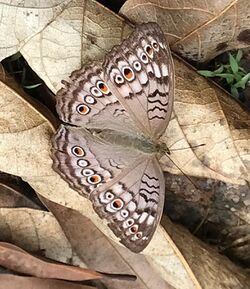Biology:Junonia atlites
| Grey pansy | |
|---|---|

| |
| In Bogor Botanical Gardens, Java | |

| |
| Ventral side in Sri Lanka | |
| Scientific classification | |
| Domain: | Eukaryota |
| Kingdom: | Animalia |
| Phylum: | Arthropoda |
| Class: | Insecta |
| Order: | Lepidoptera |
| Family: | Nymphalidae |
| Genus: | Junonia |
| Species: | J. atlites
|
| Binomial name | |
| Junonia atlites (Linnaeus, 1763)
| |
| Synonyms | |
| |
Junonia atlites, the grey pansy,[1][2] is a species of nymphalid butterfly found in South Asia.[1][2]
Distribution
J. atlites is found in Bangladesh, India, southern China, Cambodia, Indochina, the Malay Peninsula, western and central Indonesia, and the Philippines.[1][2][3]
Description
Upperside of both sexes pale lavender brown, apical half of wings paler. Forewing: cell with, three transverse, short, sinuous black bands, the outermost defining the discocellulars; a similar short, somewhat broader band beyond the apex of the cell; two transverse discal dusky black fasciae, the inner highly sinuous and outward, angulate above vein 4, the outer straighter, somewhat lunular, bordered by a series of whitish ovals with dusky or black centers. The black-centered spots in the ovals in interspaces 2, 5, and 6 margined posteriorly with rich ocherous yellow. Beyond this series of ovals is a lunular, narrow, transverse dark band, followed by sinuous subterminal and terminal broad dark lines. Apex of wing slightly fuliginous. Hindwing: a short slender black loop from veins 6 to 4 at apex of cell-area; two discal sinuous transverse dark, fasciae in continuation of those on the forewing: followed by a series of dark-centered ovals in interspaces 2–6, the ovals in interspaces 2, 5, and 6 with the dark centers inwardly broadly bordered with ochreous yellow; postdiscal, subterminal and terminal dark lunular lines as on the forewing.[4]
Underside lilacine white markings as on the upperside but very delicate, slender and somewhat obsolescent. In the dry-season forms of the males the rows of oval ocelli are only indicated by the yellow-centered ovals. The most prominent marking is the inner discal fascia crossing the wings; this is much less sinuous than on the upperside and not angulated on the forewing. In the females the markings are all heavier and more distinct, the space between the various transverse fasciae tinged with ocherous.[4][5]
Ecology
The larvae of J. atlites feed on Oryza, Pseuderanthemum, Strobilanthes, Asteracantha longifolia, Alternanthera philoxeroides, Barleria, Hygrophila lancea, and Hygrophila salicifolia.[6][3]
References
- ↑ 1.0 1.1 1.2 Varshney, R.K.; Smetacek, Peter (2015). A Synoptic Catalogue of the Butterflies of India. New Delhi: Butterfly Research Centre, Bhimtal & Indinov Publishing, New Delhi. pp. 219. doi:10.13140/RG.2.1.3966.2164. ISBN 978-81-929826-4-9. https://www.researchgate.net/publication/287980260.
- ↑ 2.0 2.1 2.2 Savela, Markku. "Junonia atlites (Linnaeus, 1763)". http://www.nic.funet.fi/pub/sci/bio/life/insecta/lepidoptera/ditrysia/papilionoidea/nymphalidae/nymphalinae/junonia/#atlites.
- ↑ 3.0 3.1 Peggie, Djunijanti; Amir, Mohammad (2006). Practical guide to the butterflies of Bogor Botanic Garden. Cibinong, Indonesia: Tokyo, Japan: Bidang Zoologi, Pusat Penelitian Biologi, LIPI ; Nagao Natural Environment Foundation. pp. 75. ISBN 9795790943.
- ↑ 4.0 4.1
 This article incorporates text from a publication now in the public domain: Bingham, Charles Thomas (1905). Fauna of British India. Butterflies Vol. 1. pp. 359–360. https://archive.org/stream/butterfliesvolii00bing#page/358/mode/2up/.
This article incorporates text from a publication now in the public domain: Bingham, Charles Thomas (1905). Fauna of British India. Butterflies Vol. 1. pp. 359–360. https://archive.org/stream/butterfliesvolii00bing#page/358/mode/2up/.
- ↑
 This article incorporates text from a publication now in the public domain: Moore, Frederic (1899–1900). Lepidoptera Indica. Vol. IV. London: Lovell Reeve and Co.. pp. 67–89. https://www.biodiversitylibrary.org/item/103628#page/79/mode/1up.
This article incorporates text from a publication now in the public domain: Moore, Frederic (1899–1900). Lepidoptera Indica. Vol. IV. London: Lovell Reeve and Co.. pp. 67–89. https://www.biodiversitylibrary.org/item/103628#page/79/mode/1up.
- ↑ Savela, Markku. "Junonia atlites (Linnaeus, 1763)". http://www.nic.funet.fi/pub/sci/bio/life/insecta/lepidoptera/ditrysia/papilionoidea/nymphalidae/nymphalinae/junonia/#atlites.
Wikidata ☰ Q714593 entry
 |






